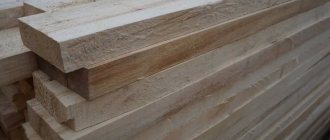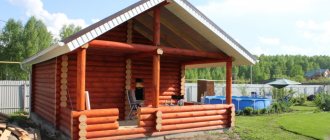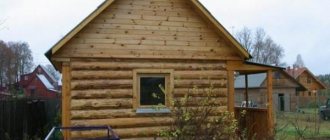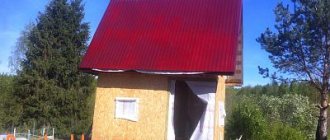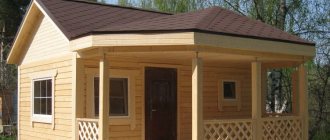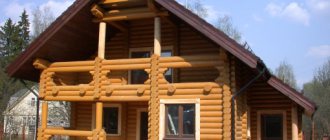Approximately 95% of those planning to build a wooden bathhouse inevitably stop at the question: which is better - from rounded logs or from profiled timber (the remaining 5% focus on personal taste and do not look for alternatives). Despite the fact that these materials are more than a century old, discussions on this issue continue to this day.
This article provides a comparison of timber and logs, as building materials for a bathhouse, according to objective criteria. Most likely, after reading it you will make your choice.
Conditions for objective comparison
But first, let’s agree on what kind of log and what kind of timber we will compare with.
We reject the following options:
- debarked log;
- carriage (Norwegian hewn log);
- profiled log;
- glued logs;
- planed timber;
- laminated veneer lumber;
- forced dried lumber.
That is, we will compare a rounded log and a profiled timber made from solid wood. Humidity is natural .
Advantages and disadvantages during construction
timber
Bathhouse made of laminated veneer lumber
Deadlines. To build a log bathhouse from timber, it takes from 2 to 7 weeks. These are average statistics for a neat small bathhouse. The start-up period after assembly of the building depends on humidity.
Shrinkage. Depends on the material. Glued gives the smallest (1-2%). Profiled and dried, up to 5%, with natural humidity, up to 10%;
Labor intensive. When using profile timber, there is an option to build the “desired house” yourself, without involving competent builders. Well, let’s say in a company of 3 people, plus the necessary tools and available mechanisms.
Finishing. Again, it depends on the type of timber. If you use a profiled one, finishing is generally not needed. If you build it from ordinary non-core material, you will have to spend money not only on finishing, but also on caulking.
Log
Deadlines. With similar dimensions, a log bathhouse can be built in the same time. This is provided that the logs are already ready. However, you will have to wait about a year for the “ribbon cutting” with a broom under your arm.
Shrinkage. On average, over a year, the log house will “sag” by 8 - 12%
Labor intensive. It is not easy to build a bathhouse without qualified builders or an experienced consultant. There are moments, ignorance of which leads to bad consequences.
Finishing. You need caulking (more than once) plus sanding.
Results
Based on the results of all of the above, we can conclude that profiled timber for the construction of a bathhouse is objectively better . It is more technologically advanced, easier to work with, lighter and warmer than logs.
However, many people like rounded logs because of their appearance . And according to all the criteria described above, this material is not critically behind timber. Therefore, if you like a log, it is not only possible to build from it, but also necessary. Moreover, modern technologies and developments in this area compensate for many of the disadvantages of rounded logs - shrinkage, cracking and other advantages and disadvantages equally, so that it looks like an objective comparison)
Features of each material
timber
It is obtained from a log, processing it from all sides using sawing. As a result, the desired section is obtained. Common section shape: square or rectangle. A triangle would not be appropriate here.
Construction from profiled timber
Feedstock:
Usually coniferous species - pine, larch, fir, cedar. Less commonly deciduous - oak, birch, aspen, linden. I don’t want to force my opinion on anyone, but Siberian cedar is the best option. The smell alone is worth it... In the old days, for example, the log house was built from aspen, the beams to support the ceiling were made of oak, and the interior was made of birch. This spoke about the taste and capabilities of the owner.
Types of timber:
- Unprofiled. Classic timber, made from solid wood. Has regular straight edges.
- Profiled . The edges are equipped with grooves (ridges) for counter connection with a similar beam. Its use allows you to avoid caulking, as well as changes in the geometry of the building structure due to shrinkage.
- The carriage is the so-called half-beam . Only two opposite sides are cut from the log. The other two remain semicircular. A log frame made from a gun carriage looks attractive and deserves due attention.
- A few words about laminated veneer lumber . Its supporting structure is 50-70% stronger than solid wood, however, the price is much higher. You can read more about it here...
“Connoisseurs of traditional bathhouses may have questions about the environmental friendliness of laminated veneer lumber. And although all manufacturers assure you of complete safety, it’s up to you to decide.”
The key point is humidity. It is better to use one that has been dried in a heat chamber. It is more expensive, but allows you to avoid the consequences inherent in timber with natural moisture.
“It’s better not to order a finished log house, because some timbers may “lead” when drying and subsequently they will become a “propeller”, which means they will have to be changed.”
Log
Well, what can I say. It’s a log, it’s a log in Africa too. But let's figure it out.
Raw materials. The same as for timber. More often coniferous, less often deciduous lumber.
Types of logs:
- Rounded . Another name is calibrated. How are they different from ordinary ones? Initially, the log has a conical shape, but with the help of special machines the “extra” part is cut off and it becomes cylindrical, i.e. a given "caliber".
- Planed . Processed with an electric planer. In this case, the top layer is removed slightly (not like the rounded ones). However, the shape here is conical. In terms of operational parameters, it is more durable for a bathhouse than the above.
- Shaped . Its technology involves removing the top layer of bark. The log retains its natural resin content, which allows it to last much longer than a rounded one.
These are the main types of processing of logs for building a bathhouse.
“Some experts believe that “cylindering” violates the integrity of the fibers (since not only the bark is cut, but also the upper, most durable part of the tree) and there is a risk of premature rotting.”
“Knowledgeable people advise buying timber cut down in winter and preferably in northern latitudes. It initially has lower humidity and higher density. It’s not for nothing that the winter forest is considered the best.”
If we talk about a log house, then, according to experts, it is better to use material with natural moisture. Why? A log house made from dried logs will not shrink normally. It does not dry out as expected, but on the contrary, it swells. As a result, the logs begin to “stick out” from the building. In addition, a dry log on a construction site will begin to absorb moisture, which can cause it to bend.
There are no questions about the environmental friendliness of logs - a natural product (if it is a forest, not near a nuclear power plant).
“When purchasing a finished log house, be sure to check for numbering on the crowns. Otherwise, the assembly will turn into a game - “find an unknown puzzle.”
All. Go ahead.
Processing logs for logs
The basic rule for building a log house is to process it exclusively with hand tools. It is clear that this rule is not always possible to follow. Nowadays, log houses are mostly not cut, but “sawing”. Not only the preparation of wood, but also the selection of a longitudinal groove and the processing of corners is done with a chainsaw. And this is understandable, the speed of construction should be as high as possible, and labor costs lower. But you need to know that with this method of processing, the capillary fibers of the wood, in which moisture accumulates, remain open. The resulting saw cuts continue to absorb and accumulate moisture. The internal moisture content of such logs will be higher than that of chopped logs. At the same time, heat loss and the risk of rotting and damage by mold and mildew increase.
When processed with hand tools - an axe, chisels, scrapers, planes and jointers, the wood capillary tubes become clogged and can no longer take in and accumulate water. As a result, the log house retains heat better and suffers significantly less. Modern craftsmen choose the best of two technologies - they save their time and labor by working with power tools and a chainsaw, but leave a few centimeters to the marks. And then they do the cutting using an ax and hand tools, closing or “plugging” the capillaries of the tree. Experts say that with this method of work, wood cuts do not differ from those processed by hand.
Modern wood materials have many advantages. Calibrated (rounded) logs, profiled and laminated veneer lumber have valuable advantages and excellent appearance. But they lack one unique property compared to a solid log. During processing, the integrity of the tree is violated, the resistant outer layers are removed and the looser inner layers are exposed. Subsequently, in order to achieve the necessary resistance to external factors, wood is periodically treated with biostability compounds, which does not make the wood more environmentally friendly, on the contrary. However, there are also folk safe and useful methods and means of processing; the only negative factor is the time factor.
A special unique property of coated wood is its high resistance to diseases.
A bathhouse made of timber or logs, which is better: conclusion
The use of timber or logs for the construction of a bathhouse is equally justified and is determined mainly by the personal preferences and financial capabilities of the customer. It is impossible to unambiguously single out any material as more suitable and convenient due to the large number of pros and cons of both timber and logs.
One should proceed from these specific conditions and possibilities that determine the final decision in favor of one type of material or another.
The final decision is best made after familiarizing yourself with the market offer, deciding on the prices and quality of the material offered. The totality of the information received will be the starting point in choosing the material. So, to answer the question: “timber or log for a bathhouse - which is better?” you now have enough information.
How to choose the right material for building a future bathhouse?
Timber wall construction.
Of course, each of you will independently choose the material for building a bathhouse. But you definitely need to know about the nuances of timber and logs in order to ultimately make the right decision.
The first thing to say is that both materials have several varieties. So, for example, timber can be glued and regular, non-profiled and profiled.
In addition, this material differs in the degree of humidity, which, in turn, has a significant impact on the properties of the timber as a whole. As for logs, they are rounded and hewn by hand.
Based on all that has been said, we can say with confidence that there is no clear answer to the question we posed, because the materials differ greatly from each other.
Choosing wood for a log house
A real log house is made from coniferous wood harvested in winter. Pine, oak, larch and ash are rot-resistant. Cedar, fir, larch and spruce are classified as moderately resistant. Deciduous wood is classified as low-resistant and unstable; this wood is more susceptible to insects and various diseases.
In terms of cost, cedar, oak and larch are much more expensive than pine and spruce. Pine wood is plastic, and when processing it with hand tools it is easier to avoid scuffing and chipping. Pine is a strong energy donor. Many specialists in wooden architecture consider pine wood to be the best material for modern private builders, and not only because of its cost-effectiveness. Spruce is also a good option, but it is a little more difficult to process and is more susceptible to various diseases. But the heat-conducting properties of spruce wood are higher than those of pine, and a spruce log house will be warmer than a pine one at the same thickness.
Moisture content of lumber
The moisture content of wood directly affects its cost, as well as the time of natural shrinkage of the walls of the house after installation. Logs, both rounded and unbarked, are sold to the consumer with natural humidity, which ranges from 30 to 80%, depending on the time of year in which the tree was cut. In winter, the movement of juices in the plant trunk stops, so this is the most favorable period for harvesting.
The timber can be dried both in drying chambers and without them. The drying method directly determines the time after which wood with the required moisture content will be ready for further processing. Drying chambers make it possible to reduce this figure to the normal value of 10 - 12% within 1 - 2 months, while a large amount of energy is consumed, which leads to a significant (twice) increase in the price of the starting material.
Durability of wood
The service life of a log house made from various lumber is longer, the less processing they have been subjected to. Therefore, the most durable log will be a debarked log, from which the dead bark is removed manually and there is no structural damage to the surface, most dense layer of wood. It is this layer that prevents moisture from penetrating into the deeper and less dense parts of the log, thereby preventing the processes of rotting and decomposition.
In the process of rounding logs, the denser surface layer is removed to looser sapwood, so the service life of logs made from them is up to 50% lower. All types of timber, except laminated veneer lumber, have approximately the same durability. Glued laminated timber stands out here too - during the gluing process, the lamellas are treated with chemical compounds, so buildings made from it will last no less than those made from a debarked trunk.
About the rules for harvesting logs for the construction of a log house
Harvesting is the most important process on which the condition of the log house will depend for many years. Coniferous wood is selected for the log house; rot and wormholes are not allowed. The wood should be even, preferably of equal thickness. Harvesting is carried out only in winter, at the beginning. At this moment, the moisture content of the wood is minimal, and the content of natural resin and essential oils, which are natural antiseptics, is the highest. Such a forest is much less susceptible to wood diseases.
The diameter of the logs is important when logging, minimum 220 mm, the largest is considered the best.
After harvesting, the timber is transported as quickly as possible to the place where debarking will be done.
When debarking, it is also important not to damage the top layer of the log, under the bark and bast. The inner loose layer is more exposed to the environment, and drying occurs too quickly
Because of this, the surface of such logs may end up with cracks. Carpenters say that deep centimeter cracks appear only in logs that were processed mechanically, with milling cutters or electric jointers.
After the bark is removed, it is collected and burned, since tree beetles and other unnecessary company usually live in the bark.
If trees are cut down at the beginning of winter, they can be kept without removing the bark until spring. During summer felling - no more than 15 days. The fungal disease, noticeable to the eye as the blue discoloration of the trunks, begins to progress when the air warms above 10⁰C. When selling timber, they always tell buyers about the complete harmlessness and ubiquity of “blue stain”, but it is still a disease, and it is better to do without it.
After the logs are debarked, they are stored in stacks with ventilated intervals of 4-5 cm for ventilation and drying. The stacks are assembled on scraps of logs or thick boards with wedge stops at the ends to prevent the logs from rolling out. Under the stack you need waterproofing - a layer of thick polyethylene film or any other rolled material.
The logs in the bottom row are preferably of the same diameter. The next row of logs is laid on boards attached to the logs of the bottom row. The boards should be no thinner than 80 mm. The stack structure must be rigid and fixed in both directions. A gable roof is installed on top of the stack to protect from rain and snow. To make it more convenient to take logs to the log house in the future, thin logs are placed below, and the thickest ones are placed in the top row.
After laying the stack, all log cuts are coated with bitumen, PVA glue or clay so that drying occurs evenly along the entire length of the trunk.
If you plan to make a log house without compaction between the crowns in order to disassemble and re-arrange it permanently in six months or a year, then you can start cutting from undried logs. But if you are cutting a log house for a permanent place, immediately with inter-crown seals, then you need to take logs that have dried in a stack for at least 1 year.
Everyone understands that if you cut it from a damp forest, and in order to avoid the problem of mold and mildew, do a copious antiseptic treatment, there will be no particular benefit from such a tree. In addition, it may not help, since the wood, which has moisture inside, cannot be saturated with an antiseptic; it will only affect the top layer of the log. Even worse is to varnish raw wood, even with antiseptic treatment. This is a sure way to create conditions for the rapid spread of rot in the inner layers of the tree. The service life of such a log house can be approximately estimated at 15-20 years, in conditions of constant deterioration in environmental friendliness and safety. Drying logs to “equilibrium” moisture content should take at least two years, this is the traditional technology. And if you follow it, then you will not see cracks in the walls, strong shrinkage of the house and various cracks in the corners in your house, as well as wood diseases. A wooden frame can last more than 100 years; this has been proven over centuries of construction practice. Will serve both children and grandchildren.
The next topic is about the design of the log house and cutting methods.
Which log house is better for a bathhouse?
Log buildings vary in total area and number of floors. For a bathhouse, they often prefer a small one-story log house with a terrace, the area of one floor is 30–50 m2.
Logs for log houses can be hewn (planed) or galvanized (with the outer layer cut to a given diameter).
In what ways does it lose to hewn:
- cracks appear earlier and larger;
- the log house looks unnatural;
- processing technology removes the densest sapwood;
- wood quality indicators visible on the outer layer are hidden;
- processing technique - with a miter saw, a milling cutter - makes the wood more vulnerable, the log rots and collapses more quickly (an ax and a plane do not saw, but chop, not “shaggy”, but flattening the fibers);
- requires more impregnation consumption;
The main advantage of logs that have gone through a rounding machine is the speed and ease of erecting walls.
Semicircular joints of the same width are not blown through and make the wall more stable.
As a result, the owner receives a beautiful log bathhouse, which does not require additional wall cladding.
But the performance qualities of a log house are much higher if the cambium of individual logs is manually trimmed (the layer immediately under the bark, hygroscopic and attractive to bugs).
In this case, only 1-2 annual rings of the sapwood (the layer between the core and the cambium) should be captured, and the surface should be well sanded.
Information.
The plane removes too thick a layer of wood. A scraper is a more gentle tool designed specifically for this operation.

